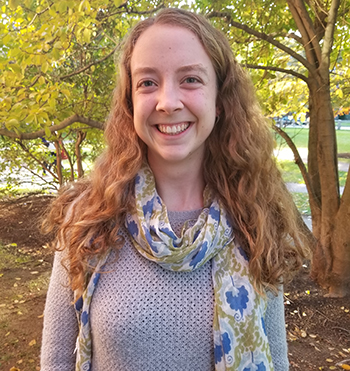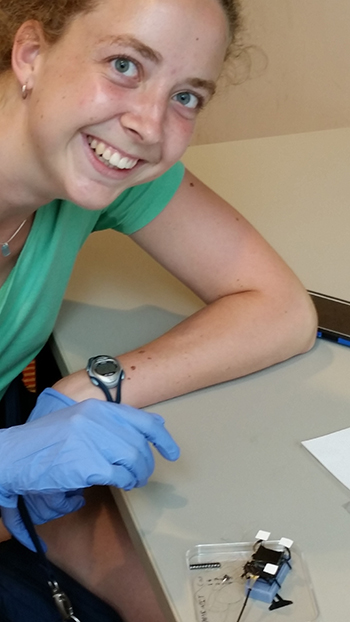 Follow along as Lyra Wanzer builds an electroadhesive treaded robot for her senior capstone project
Follow along as Lyra Wanzer builds an electroadhesive treaded robot for her senior capstone project
Lyra Wanzer, S.B. ‘19, concentrating in mechanical engineering at the Harvard John A. Paulson School of Engineering and Applied Sciences, is working on an electroadhesive treaded robot in the Microrobotics Laboratory of Robert Wood, Charles River Professor of Engineering and Applied Sciences, for her project in “Engineering Design Projects” (ES 100). The capstone course challenges seniors to develop a creative project that solves a real-world engineering problem.
Wanzer is designing a robot that will look like a miniature tank and have the ability to climb conductive surfaces with its electroadhesive treads. The electroadhesive treads will behave like a parallel plate capacitor, so that when high voltage is applied to the material of the treads, a force is created between the plates and the conductive surface. Miniaturized robots like the one Wanzer is developing can be used to explore small places, which can be highly useful for inspection, as well as for search and rescue. Wanzer is excited about the potential robotics has to help make inspections safer.
She began working in the Harvard Microrobotics Lab in the summer of 2017 through PRISE, a competitive 10-week summer residential program for Harvard undergraduates engaged in research in the sciences or engineering, where she designed a tail for the Harvard Ambulatory Microrobot (HAMR). From that experience and the lab group meetings she attends to learn about the variety of techniques used throughout the lab, Wanzer has a wide breadth of ideas and lab skills to draw on for her project. She is working to tailor the appropriate lab techniques to her robot.
 One key lesson Wanzer has learned in her thesis project is how to chart her own path. Unlike academic courses that have a fairly straightforward path of what needs to be done, Wanzer’s project has challenged her to make self-driven plans and to set aside blocks of time in her schedule dedicated to thesis work, which involves calculations, SolidWorks modeling, and manufacturing time in lab. Over the summer, Wanzer worked on initial calculations to determine the feasibility of her project. Her plans continue to evolve as she adapts to the challenges that arise from the design of the microrobot.
One key lesson Wanzer has learned in her thesis project is how to chart her own path. Unlike academic courses that have a fairly straightforward path of what needs to be done, Wanzer’s project has challenged her to make self-driven plans and to set aside blocks of time in her schedule dedicated to thesis work, which involves calculations, SolidWorks modeling, and manufacturing time in lab. Over the summer, Wanzer worked on initial calculations to determine the feasibility of her project. Her plans continue to evolve as she adapts to the challenges that arise from the design of the microrobot.
Wanzer is currently working on prototyping treads using different materials and manufacturing techniques. She is planning many iterations to help her identify the most effective manufacturing processes.
She first became involved in robotics during high school, when she joined her school’s FIRST FTC robotics team. Wanzer has been part of the Harvard Undergraduate Robotics Club for the past two years, as well.
“The engineering community is very tight-knit at Harvard; There is so much collaboration from working on problem sets and final projects together. Everyone is here to support each other,” she said.
Wanzer’s experience in robotics has trained her in multiple disciplines, such as mechanical design, electronics, and computer science, and taught her how to integrate them together.
“You have to be thinking about everything all at once, which is why I like robotics,” she said.
Stay tuned for further updates on Wanzer’s capstone project.